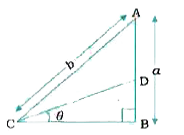Complete Solutions to Other Important Examples of chapter INTRODUCTION TO TRIGONOMETRY of Class 10 book with complete answers and questions
| Class 10 | MATHS |
| Chapter | INTRODUCTION TO TRIGONOMETRY |
| KUMAR PRAKASHAN | Other Important Examples |
| Number Of Questions | 28 |
| Academic Year | 2023-24 |
If cosecA = `sqrt(10)`, find the other five trigonometric ratios.
View SolutionIf sin A=`1/3`evaluate cos A cosec A + tan A sec A
View SolutionIf `sinA=1/2`, show that `3 cos A - 4 cos^(3) A= 0`
View SolutionIf `sintheta=(a^(2)-b^(2))/(a^(2)+b^(2))`, find the values of other five trigonometric ratios.
View SolutionIn the given figure , `angle B = 90°, angleDCB = theta` and `AD = BD`. Find the values of `sintheta. cos theta. tan theta` and `sin^(2)theta+cos^(2)theta`.

View SolutionEvaluate each of the following :
`sin30^(@)cos45^(@)+cos30^(@)sin45^(@)`
View SolutionEvaluate each of the following :
`tan30^(@)sec45^(@)+tan60^(@)sec30^(@)`
View SolutionEvaluate each of the following :
`tan60^(@)cosec^(2)45^(@)+sec^(2)60^(@)tan45^(@)`
View SolutionEvaluate each of the following :
`3cos^(2)30^(@)+sec^(2)30^(@)+2cos0^(@)+3sin90^(@)-tan^(2)60^(@)`
View SolutionShow that
`2(cos^(4)60^(@)+sin^(4)30^(@))-(tan^(2)60^(@)+cot^(2)45^(@))+3sec^(2)30^(@)=1/4`
View SolutionFind the value of x in the following equation `sin 2x = sin 60° cos 30° - cos 60° sin 30°`
View SolutionIf `theta` is an acute angle and `tan theta + cot theta = 2` , find the value of `tan^(12)theta + cot^(12)theta`.
View SolutionGiven that
`sin (A+ B) = sin A cos B + cos A sin B` , find the value of `sin 75°`.
View SolutionProve that :
`(cos80^(@))/(sin10^(@))+cos59^(@)cosec31^(@)=2`
View SolutionEvaluate the following :
`(2tan53^(@))/(cot37^(@))-(cot80^(@))/(tan10^(@))`
View SolutionExpress `sin 72° + cot 72°` in terms trigonometric ratios of angles between `0°` sand `45°`.
View SolutionEvaluate: `((sin47^(@))/(cos43^(@)))^(2)+((cos43^(@))/(sin47^(@)))^(2)-4cos^(2)45^(@)`
View SolutionIf `sec 5A = cosec (A + 36°)` , where `5A ` is an acute angle, find the value of `A` .
View SolutionProve the following : (All angles are acute angles.)
`sqrt(sec^(2)theta+cosec^(2)theta)=tantheta+cottheta`
View SolutionProve the following : (All angles are acute angles.)
`(1+tan^(2)theta)(1+sintheta)(1-sintheta)=1`
View SolutionProve the following : (All angles are acute angles.)
`(tantheta+sintheta)/(tantheta-sintheta)=(sectheta+1)/(sectheta-1)`
View SolutionProve the following : (All angles are acute angles.)
`(sintheta+costheta)/(sintheta-costheta)+(sintheta-costheta)/(sintheta+costheta)=2/(sin^(2)theta-cos^(2)theta)`
View SolutionProve the following : (All angles are acute angles.)
`tantheta-cottheta=(2sin^(2)theta-1)/(sinthetacostheta)`
View SolutionIf `sintheta + sin^(2)theta = 1` , prove that `cos^(2)theta + cos^(4)theta = 1`
View SolutionIf `cos theta + sin theta = p` and `sec theta + cosec theta = q` , prove that `q (p^(2) - 1) = 2p`.
View SolutionIf `costheta + sin theta = sqrt2 cos theta`, prove that `cos theta - sin theta = sqrt2 sin theta`.
View SolutionProve that
`2 (sin^(6)theta +cos^(6) theta ) - 3(sin^(4)theta +cos^(4) theta ) + 1 = 0`
View SolutionIf `x sin^(3)theta + y cos^(3)theta = sintheta costheta` and `x sin theta = y cos theta` , prove that `x^(2) + y^(2) = 1.`
View Solution
Other Important Examples questions and complete solutions for chapter INTRODUCTION TO TRIGONOMETRY of KUMAR PRAKASHAN of Class 10